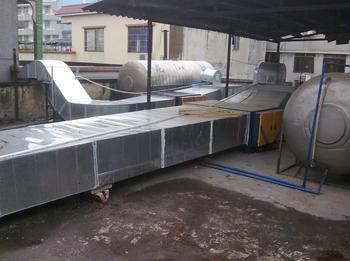通风管道工程是一个涉及设计、安装和维护通风系统的综合工程,主要包含以下几个方面:
Ventilation pipeline engineering is a comprehensive project involving the design, installation, and maintenance of ventilation systems, mainly including the following aspects:
设计阶段:
Design phase:
室内环境要求:根据建筑物的用途和特点确定通风系统的设计需求,如室内温度、湿度、空气质量等。
Indoor environmental requirements: Determine the design requirements of the ventilation system based on the purpose and characteristics of the building, such as indoor temperature, humidity, air quality, etc.
管道布局设计:根据建筑物的平面布局和空间限制,确定通风管道的走向、位置和连接方式。
Pipeline layout design: Determine the direction, location, and connection method of ventilation ducts based on the building's plane layout and spatial limitations.
风量计算:根据建筑物的面积、人员数量、活动特点等因素,计算所需的通风风量,确定通风系统的尺寸和容量。
Air volume calculation: Calculate the required ventilation air volume based on factors such as building area, number of personnel, and activity characteristics, and determine the size and capacity of the ventilation system.
材料选择:选择适合的通风管道材料,考虑其耐腐蚀性、隔音性能、绝热性能等因素。
Material selection: Select suitable ventilation pipeline materials, considering factors such as corrosion resistance, sound insulation performance, and thermal insulation performance.
材料采购:
Material procurement:
通风管道材料:根据设计要求,采购合适的通风管道材料,如镀锌钢板、不锈钢板、铝合金板等。
Ventilation duct materials: According to design requirements, purchase suitable ventilation duct materials, such as galvanized steel plate, stainless steel plate, aluminum alloy plate, etc.
配件和附件:购买所需的管道连接件、弯头、三通、法兰等配件,以及密封材料、绝热材料等附件。
Accessories and accessories: Purchase the necessary pipeline connectors, elbows, tees, flanges and other accessories, as well as sealing materials, insulation materials and other accessories.

施工安装:
Construction and installation:
管道制作:根据设计图纸和要求,进行通风管道的切割、弯曲、焊接、连接等加工工艺,制作成所需的形状和尺寸。
Pipeline production: According to the design drawings and requirements, carry out machining processes such as cutting, bending, welding, and connecting the ventilation pipeline, and make it into the required shape and size.
安装调试:将制作好的管道和配件进行安装,确保连接紧密、密封良好,根据设计要求调整通风系统的风量和风速。
Installation and debugging: Install the prepared pipes and accessories to ensure tight connections and good sealing. Adjust the air volume and wind speed of the ventilation system according to design requirements.
防火措施:根据建筑物的防火要求,采取防火隔离、防火涂料、防火封堵等措施,确保通风管道的防火性能。
Fire prevention measures: According to the fire prevention requirements of the building, measures such as fire isolation, fire retardant coatings, and fire blocking are taken to ensure the fire prevention performance of the ventilation pipeline.
系统验收:
System acceptance:
测试检查:对已安装的通风系统进行测试和检查,包括风量测试、压力测试、噪音测试等,确保系统符合设计要求和标准。
Testing and inspection: Conduct testing and inspection on the installed ventilation system, including air volume testing, pressure testing, noise testing, etc., to ensure that the system meets design requirements and standards.
故障排除:发现系统运行中的问题和故障,并进行及时修复和调整,确保系统正常运行。
Troubleshooting: Identify problems and malfunctions during system operation, and make timely repairs and adjustments to ensure normal system operation.
完工验收:经过所有测试和调试后,进行通风管道工程的更终验收,确保通风系统达到预期效果。
Completion acceptance: After all testing and debugging, the final acceptance of the ventilation pipeline project is carried out to ensure that the ventilation system achieves the expected effect.
维护与管理:
Maintenance and Management:
定期清洁:对通风管道进行定期清洁,去除积尘
Regular cleaning: Regular cleaning of ventilation ducts to remove dust accumulation
上一篇:各种消防排烟系统通风管道安装方式
下一篇:通风管道厂家是如何对风管进行维护的?
